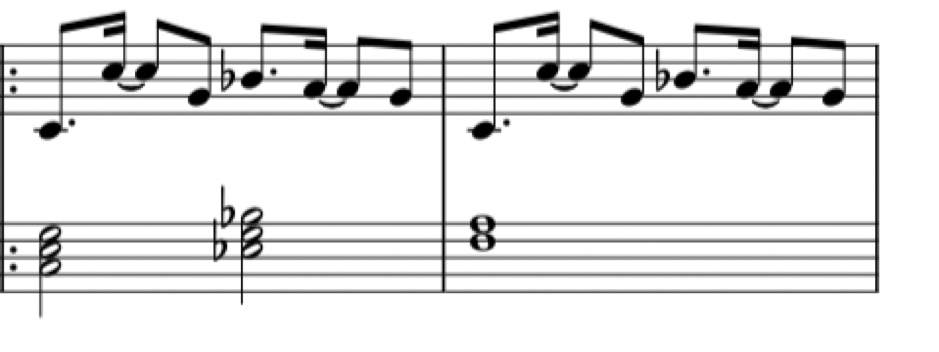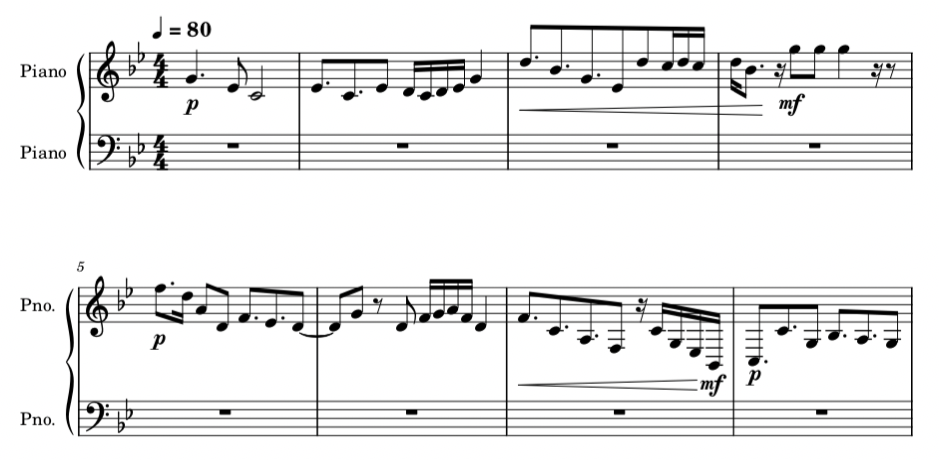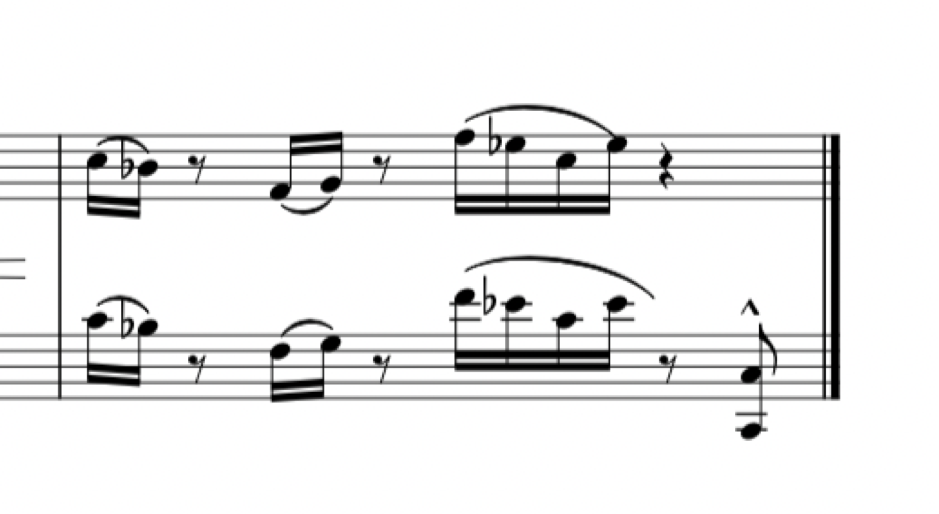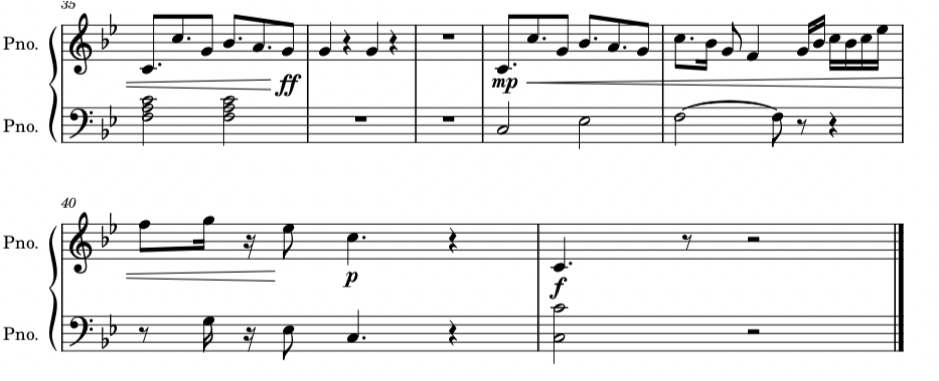This is part 3 in a series of awkward devlogs where I talk about the various subsets of game development, and why I suck at at them.
Part one (art) is here, part two (coding) is here
As usual, this post is mirrored on my personal website
The modern expectation of a videogame is some software that responds to user input to generate audiovisual feedback. Even with this barebones description, you have three very distinct fields to grapple with- some kind of coding to tell the computer what to do, some kind of audio skill to generate the sound, and some kind of artistry to generate visual feedback (That’s before getting into all the other hidden soft skills). I have yet to speak to someone who hasn’t at least struggled with one of these. Here’s how I (try) to tackle one of them
Today We’re gonna cover how to go from a cold-start of knowing nothing, to (starting) to make music, then we’re gonna have a case study ofa track I produced on essentially a dare.
Today’s subject- Music! I suck at it, and you can too!
Music is a funny beast. With Art, we have an intuitive feel for if something looks good- and most of us have been playing with crayons since before we could walk. We have direct, hands on experience with Art. While it’s less true nowadays, we almost all use a pen or a pencil in our daily lives- unconsciously practicing mark-making that can be transferred to art. With coding- it’s maybe less intuitive- but cost of entry is almost nil (barring a computer, of course). There are more free resources for getting into programming and coding than I could possibly name, ranging all the way from scratch, to software design patterns in c++. If you really want to splash the cash, you can buy a book for 5, 10 or maybe even 15 whole dollars, to ensure some baseline quality of instruction.
Making music is tricky, in that it’s neither super intuitive like visual art, nor is received wisdom that it’s low cost of entry. We use our voices every day, sure, and most of us can sing, or “sing”, but the majority of us don’t associate that with musical notation or concepts (unless for a pre-existing hobby or career).
The usual cost of entry for “learn to music” is either an instrument and a recording device (expensive!) or moderately expensive software (e.g. ableton live, FL studio, Sibelius). Not exactly something you pick up on a whim.
Then, as a surprise, you discover that learning the software, or learning to play an instrument does not automatically teach you how to produce music, which is an entirely new, different skillset that for some reason your elementary school piano teacher never deigned to mention.
Or maybe, that’s just me being bitter.
Good news! Turns out that in recent years, a number of free music production software solutions have become available- I can tentatively recommend MPC beats as a decent Digital Audio Workstation, and musescore is a pretty handy notation (and in a pinch, playback) suite.
So that’s the barrier for entry taken care of- you now have access to the tools that you need to produce a decent track, how do we use them? Like I said- knowing how to use the *software* is not the same as knowing how to make *music*.
If you have absolutely no, or very little musical background- here’s what you need to do.
That was a little preachy no? Well, let’s see how 4 looks in practice.
So, about a year ago I was challenged to make a track using the motif from Countdown (for those of you who don’t know it, it’s like a gentle, televised version of scrabble, popular with the elderly and people whose favourite flavour is ‘plain’).
Sample the theme here.
Additionally, the final track had to utilise a clavichord, and be ‘tender’.
Below are my notes on the composition process. These are long winded! If you want, you can just skip to the sheet music, or the final track, or you can read the full thing for my full process.
This was a reasonably straightforward decision: aside from the mandatory instrument (Clavichord bass, subbed for a harpsichord because life’s too short) I really wanted something that supported the ‘tender’ theme. Two things come to mind when I think of this- the first is a fashionably scruffy pop/country/folk musician, sitting on a stool in an otherwise empty stage, gently plucking the strings of an acoustic guitar, while crooning about how s/he misses their ex but they can never be, or how they had an affair, but it made them sad or whatever. The second is a fashionably underdressed pop/classical/jazz musician sitting at an open grand piano on an otherwise empty stage, gently tapping the keys while they sing about their ex.
At a distant third- we have a woman expressively plucking at a harp. She doesn’t sing, but you can tell that she’s thinking about the ex she had an affair with and it’s really sad because they can never be not ever even if they really want to.
I’m more familiar with piano, so piano to carry the melody it is.
In my mind’s eye I’m thinking of something like Agnes Obel’s ‘familiar’ in terms of vibe- which supports the piano with harp, distorted vocals and subtle effects- sparse drum hits and wide, wide effects and textures- or some of the slower or more ambient Florence and the Machine tracks- with flutters and flourishes from strings scattered throughout.
So I throw down my initial list of instruments: a piano to carry the main melody- a ***ichord bass, NO DRUMS NONE AT ALL, swells, and textures. No vocals because I cannot sing.
My own transcription and google claim that the main countdown motif looks something like this- the distinctive melody and three chords repeated until the ‘times up’ gong.

Having transcribed the theme into my DAW and assigning the treble to a piano and the bass to a harpsichord VST, I’m hit with a very immediate and obvious problem. The countdown theme famously plays for (iirc) 30 seconds, before ending on a conclusive BONG that tells the tame nerds on the show they should put their pencils down. This is by design quite short, and quite tense. First port of call is to reduce the speed from a steady 120bpm to a more leisurely 80bpm, this makes it slightly longer, but now it’s boring instead of tense.
The majority of the theme is enclosed in three bars- of those three bars, the melody is identical in two of them. We need to introduce some Complexity! Rather than try and embellish the main theme to make it more interesting, I decide to treat it like a chorus section- have it be a kind of motif that the track returns to.
In my mind it goes something like
Now I’ve set down some more parameters and bounds of what I’m thinking of putting together, structure, instrumentation, and so on, I jot down a few more expanded thoughts on what I want the track to feel like.
I want to stay true to the ‘flavour’ of the countdown theme, in that there’s an obvious conclusion- but falling in line with the ‘tender’ adjective- I don’t want it to be a straightforward ratcheting up or build up- the intensity should grow gently, falter, and the track should unravel at its own pace. Thinking more like a flower blooming than a firework going off. I take this on board and feed it forward- instruments should be gradually added and texture and complexity should ramp up gradually, with one or two elements where it takes two steps forward and one back.
I sit my FAT ASS down and start bashing out a melody for the ‘verse’. The risk of this is that there ends up an obvious disconnect between what I’ve put together and the source material, with neither really gelling - so I have a quick look at the ‘chorus’ melody before I start anything serious.
My take home message is that the melody has a *lot* of dotted quavers, so I decide that that’s a theme I’m going to absolutely *beat to death*- if I’m lucky it’ll end up sounding syncopated and interesting, and if I’m dumb, it’s going to sound like a muddy mis-timed mess.
The main melody seems to be in C minor- so I put the melody section I write into C Dorian, because I learned about different modes recently and thus will shoehorn them into anything and everything I can. In principle this should work- C minor and C Dorian are one flat different, so it should sound almost as dark as C minor, but not quite.
I decide to build off of the following Dorian chord progression-. i,v,ii,IV, because it sounds cool. I like the tension of the three minor chords finishing on a major.


To stop things feeling too lively, we pick about two bars per chord- with the last bar being a copy of the main chorus section- to really ‘stitch’ the sections together. It ends up sounding inoffensive, and that’s GOOD ENOUGH FOR ME.
I throw everything together in my DAW and start adding instruments and sounds to build the feeling I’m looking for. The first thing I do is add REVERB-ERB-ERB-ERBBBB to my piano VST and adjust the dynamics to spice up the simpler sections. Big wide, empty sound. I add in some orchestral swells under the piano that lazily slosh between the chord notes- the goal is to re-enforce the chords used and fill in the ‘gaps’ in the track where the piano’s doing the heavy lifting.
I add in a high-pitched synth pluck once per bar- the plan here was to have this ‘keep pace’- like the countdown clock ticks- but rather than once a beat, once a bar, to dial down the energy. It’s quite a sharp sound too, and I didn’t want to crowd out the interesting sounds underneath, so once a bar feels like plenty.
The first verse I keep reasonably stripped down- I don’t want too much happening in the first section, and the melody is already busy enough to engage the listener.
The second verse is largely the same as the first, but with harpsichord backing. Rather than have it hammer out the chords as in chorus 1 (see below) I have it run through the chords as a descending arpeggio. I do this because the harpsichord has a really harsh ‘twangy’ attack and it feels pretty aggressive to hit the three notes of the chord at once. Arpeggiating them spreads that initial impact over a series of lower monthly instalments and makes it easier to manipulate the dynamics smoothly.
Also- as an utter simpleton, it means I get the benefit of a non-static bassline but without the HARD THINKS required to write something of any degree of complexity. If challenged, I plan to cite a bunch of Beethoven out of insecurity.
Letting the choruses just run without variation is not all that interesting! So, this is where I introduce new elements- though that by itself still feels predictable. It’s also where I ratchet up the intensity- in the first chorus I introduce the harpsichord for the first time and have it just bang out the chords without too much variation- though there’s a cheeky key change for one bar in the first chorus to trick the listener into thinking things might be going somewhere. (lies- they do not)
The second chorus is where I decide we’re going to reach max intensity and tension- just before the release of the last bars- rather than just trudging straight into the chorus as we did in the first section, we put in a bar of keystrokes that signal a Change- and also peel away the high plucks- this lets me start from a place of lower energy than we started. In my mind, it’s like taking a step back so you can get a better run at a jump.
At this point I realise that I actually don’t like using the clavichord as a bass- The attack is too harsh and it either feels overly quiet or irritatingly piercing. In the second verse I tried to mitigate this by splitting it over arpeggios- but this SIMPLY WON’T DO for this section- arpeggios ‘roll’ too much, they don’t have the kind of impact or momentum I want for the penultimate section.
On the other hand, straight chords don’t sound that great to me in this section! IF ONLY THERE WAS SOME MIDDLE GROUND??!
Anyway, I break the chords with semiquaver intervals, and it gives this nice shimmery effect which I don’t dislike! As this section progresses I turn the chords from fifths, to sevenths, and the semibreve chords eventually get turned into reduplicated minim chords, to increase the amount of activity towards the end.
My bet is that the high pluck has been forgotten about by the end of this section- so dump it back into the last two bars of this section on the 3rd beat to give it this “victory lap’ feel, where the very first element is re-introduced.
The final part gives me a little bit of a problem- in my initial arrangement I preserved the iconic “dedum_dedum_diddily dum_ BONG” phrase- I was really split on whether to keep it in this way.
On one hand- it seemed very silly to try and build this atmosphere, embellish the original sections into a crescendo with an attempt at emotional resonance, build tension with that last rest- and then dump the listener with the unmistakable, asinine ending jingle. It turned the whole track into a joke- a audio shaggy dog story.
On the other hand- I found this joke *incredibly funny* and was sorely tempted to either leave it as is, or up the tempo and filter/replace the instruments to make it sound cheesy and tinny.
In the end I decided that this was not really playing to the spirit of the exercise, and was left with how to ram the square peg I was left with into the carefully crafted round hole I had just made.
The main goal in my mind is to take those last few bars and in some way dress them up to seem respectable and also keep them in line with the tone of the rest of the track. The first thing I do is take out the clavichord trill that in the original arrangement is meant to imitate an analogue clock alarm. That gets replaced with an orchestral swell. The logic is: Swells are classy- trills are tacky.
Trying to gussy up the last melodic part wasn’t as obvious- after severely taxing my smooth brain for a bit, I realise that the major issue I have is the rests between the quaver pairs and quaver quad- they bring the musical flow to a juddering halt- appropriate in the original context of “STOP WRITING NERDS” but less so when trying to make emotional impact.

After a few false starts I put together an expansion of the original end melody that trims out the rests- filling the space with a few little flourishes that eventually slows and lands on C- the idea is that by skittering about the tonic chord for a bit we can burn off some of that musical ‘momentum’ we built in the previous section without ending up in a situation where we’re slowed down but feel like we haven’t resolved to the I chord properly.

Oh, then we add the BONG- (a bunch of C’s, and a swell). Countdown needs the BONG. It’s non-negotiable.
On a re-listen, it still feels incomplete, especially in the latter section. I look back at my initial notes and see that in my instrument list I’ve got ‘strings’ written down as a possibility- but I haven’t used anything that’s got that nice smooth attack (excepting the swells- which I’ve been treating more like an effect). Ideally, I’m looking for a bass string- because it turns out even the bass notes of the harpsichord feel really reedy and weedy, and I want something BIGGER to give weight to the final chorus.
I have a look through my pads, but I can’t quickly find something that is in keeping with the rest of the track. I eventually find a cello sample set buried in my archives. I bang it into the chorus and fall in love with it instantly- the rich bass timbre is like wrapping the track in chocolate.
Immediate big problem though- is that the Cello ends up being like a black hole in the track- the minute it turns up, it becomes the Cello Song, where it crowds out absolutely everything else. My solution here is I take the second chorus, and I only introduce the cello half way through- following a bar of faux echo from the piano. This is nice as it adds that extra flair to what was otherwise quite a samey section of the track and reigns in the cello a little bit.
lol
Less said about this the better.
The major issue with the track is that the piano has reverb. Then the swell has some built in reverb- then the high pluck has some reverb. As soon as any of these reach any kind of volume at all- the reverb takes over and washes everything out and muddies it up.
Spent a bit of time reigning this in, ended up automating the piano reverb so when it gets louder, the reverb is ducked. The pluck was WAY too loud anyway, and blotted out anything happening round about the same time. Honestly still sounds like a mess, but less messy than before and that’s PROGRESS MY DUDES.
Next order of business was to reign in the cello- EVEN THOUGH it’d limited its’ range, it still absolutely dominates whenever it occurs. Naturally, I turn down the velocity of the cello hits. In the end, I ended up automating the volume control of the cello channel and cranked it like it was a jar of pickles that just won’t open. This wasn’t ideal, since my DAW doesn’t have an obvious way of interpolating automation points- so I can’t hear it, but I know it’s going to sound grainy to someone.
I read somewhere that you want your instruments panned slightly apart from one another to separate them out. So bass clavi gets panned slightly left, piano slightly right, swells were panned wide, and cello was further left. Did it make it feel cleaner? Maybe? If in doubt- do things without understanding or appreciating why!
I tried to EQ and it MOSTLY worked, but EQing the clavichord wrecks me again- putting a high pass anywhere near the fundamental and you absolutely kill it. There’s seemingly a large amount of high harmonic content, probably what makes it feel so piercing. probably should’ve did something about that before now. too late, baked in this terrible instrumentation now.
At some point I decide to cut my losses and just stop touching things and export the track. And that’s how I know mixing is done.
If I had a smarts- I probably should’ve duplicated the piano and had one version purely reverb (wet) and one purely dry, and then fade each one in and out as required.
At some point I also learned what gain staging is, and what the numbers and units on my EQ dials and that mean. That might be useful.
I might use some compressors or sidechain filters to bite down on things like the reverb on certain instruments, or control the high pluck. I shied away from these this time because last time I played with compressors, I had a Bad Time.
I’d probably think about adding more bass textures and higher pluck or pad style fills at the climax. Maybe. Maybe not. Feeling like I could stretch out and fill out the final crescendo- but that stretches the brief, also requires mixing skills I don’t currently have.
There’s milage imo to extend the track into something longer- varying the verse some more and starting with smaller callbacks to the source, increasing them slower- but that’s maybe a future me exercise
Agnes Obel- Familiar
https://open.spotify.com/track/2vrlwBektfeVBjTcyMUECj
Aemma - House of Hym
Anna McLuckie - get lucky
Florence & the Machine – What the water gave me
Did you like this post? Tell us
Leave a comment
Log in with your itch.io account to leave a comment.